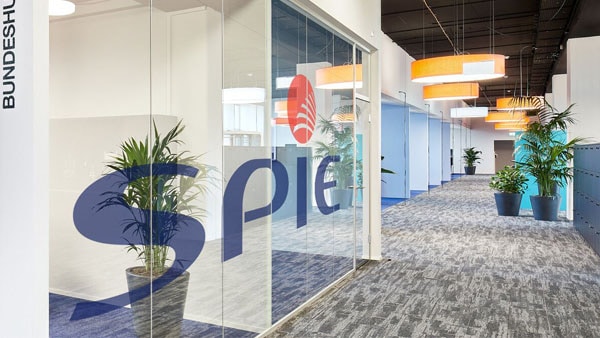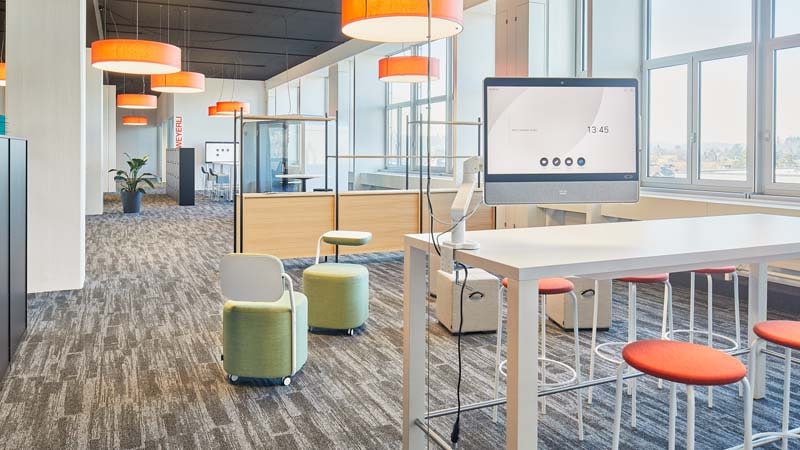The engagement includes an upgraded Cisco on-premises solution, cloud security from Cisco Umbrella, and Webex. It allows SPIE to connect multiple Internet of Things (IoT) devices to its network and establish a consistent telepresence throughout the building. The result is the smart, flexible workspace desired by SPIE, with a range of features to suit different work styles.
"After the pandemic, we didn't need to force people back into the office," says Korinna Meylan, director of human resources at SPIE Switzerland. "Everyone can choose the workspace that best fits their needs."
Creating a network to support a smarter workspace
Some of the more eye-catching features of the Bern office include sound-absorbing curtains, ergonomic furniture, and the use of plants as a service. There is also a gaming and table tennis area. On a more practical level, there is a mix of quiet areas, coworking spaces, shared desks, and private rooms.
The smart building features are more hidden. The Cisco network connects SPIE to a range of functions geared to creating a smarter, healthier, and more productive space to do work. There are sensors to monitor carbon dioxide and air quality, signage to show desk or room availability, and smart lighting and building access. There are charge points for electric vehicles and signs to direct arrivals to empty parking spaces. All of these touchpoints rely on the Cisco network; all are kept secure and segmented through Umbrella.
Another helpful product the team at SPIE Switzerland noted was Control Hub, a single dashboard to manage all Cisco collaboration solutions simultaneously. "The Control Hub is unbelievably cool, especially the [Cisco ThousandEyes] dashboard view," says Andres Gees. "I've seen a lot of solutions, and this is the best I've used. You can see how your environment is working, how often something is used, or where you face problems in quality and security, just to mention some of it."
Webex also offers a Microsoft Teams Room (MTR) setup for some Cisco devices. "And this is again something very cool in Webex that we will be able to offer after first quarter 2023 to our customers," says Andres Gees. The Cisco Webex Suite today offers an open, complete, secure, and affordable platform for all needs: collaboration, meetings, events, webinars, polling, calling, contact center, and open Communications Platform as a Service (CPaaS) interoperability. MTR setup for Cisco devices is the latest development with Microsoft. With Webex, it's easy to lead customer organizations toward digital automated processes so they can focus on their own business. Employee and customer experiences will lead to a successful and highly valued collaboration area with Webex. Framed with great management tools (Control Hub), built-in Cisco security, and leading API interoperability, this is the complete and competitive platform for Unified Communications as a Service (UCaaS), Contact Center as a Service (CCaaS) and CPaaS. "Finally, SPIE can say: we are the only Partner who can support our customer in all these areas of Webex Solutions," says Andres Gees.
Prominent in all of SPIE's meeting spaces are Cisco Board Pro devices. The Cisco Board is a presentation platform, digital whiteboard, and multiplatform conferencing tool, all rolled into one flat screen monitor.
When an employee, partner, or customer enters a room, the system recognizes the presence of the Webex App on their device and automatically connects them to the board. Once connected, users can input to the board, share files and whiteboards, hold meetings with remote users, and more. Remote users can join a meeting from anywhere through the Webex App.
"This is a huge improvement to workplace collaboration," says Korinna Meylan. "We know employees have used the app in different locations, at different times of the day, for different workloads. We've had consistently excellent feedback."
The environment is so effective because the solution is holistic. The engagement with Cisco establishes a single view—from network performance, to access, to the end user experience.
Engaging with customers while lowering costs
SPIE's new way of working reduces costs. Compared to its old offices, the Bern layout requires less floor space; the number of workstations has been reduced from 130 to 84. This has resulted in lower rental costs and utility bills. With Webex technologies and Cisco devices, SPIE has achieved a 30-percent cost optimization with its new facility.
As it learns more about how the space is being used and explores the use of new technology, the modular, open plan of the hybrid office allows SPIE to adjust space utilization on the fly. "We're really free to change things," says Oliver Wieczorek. "We can create more desk spaces or fewer, have more quiet corners or more full operation areas, and so forth. We can also adapt to periods, as we might see soon, where there is less energy available for heating."
As hoped, SPIE's living showroom is attracting interest from clients. "Bern is now a hub for customers," says Oliver Wieczorek. "They can meet here. They can work on projects with us. If we hold an event on site, customers can work in one of our shared spaces from, say, one o'clock until four when then the event starts. Then, when it ends at five thirty, they can do their final emails before going home. For us, this is a very good development. Having much more interactivity and being much closer to our customers helps us better understand them. Everybody who visits says this is really extraordinary."
The new offices have proven a big hit with existing employees and job applicants.
"I think our employees appreciate our mobile work policy and being given tools that make that possible," adds Korinna Meylan. "We have created a framework to give our employees the greatest possible freedom to decide themselves how to organize their work."
SPIE firmly believes that living the philosophy it is selling will pay big dividends down the road.
"We can really show that SPIE is on the cutting edge with new solutions," Meylan continues. "I think this is really attractive to customers and to employees. They can trust us to do more than just talk about these solutions because we live with them every day. This is a key element of our message: we live what we do."


